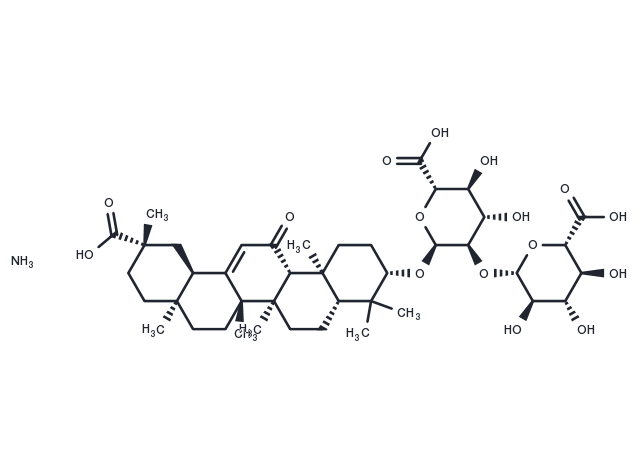Powder: -20°C for 3 years | In solvent: -80°C for 1 year


Ammonium Glycyrrhizinate (Glycyram) inhibits the cytopathology and growth of several unrelated DNA/RNA viruses.

| Pack Size | Availability | Price/USD | Quantity |
|---|---|---|---|
| 100 mg | In stock | $ 29.00 | |
| 1 mL * 10 mM (in DMSO) | In stock | $ 46.00 |


| Description | Ammonium Glycyrrhizinate (Glycyram) inhibits the cytopathology and growth of several unrelated DNA/RNA viruses. |
| In vitro | Ammonium glycyrrhizinate (AG) markedly protects AGS cells from H(2)O(2)-induced damage as measured by the integrity of actin cytoskeleton. AG also dose-dependently inhibits FeSO(4)-induced reactive oxygen radicals. |
| In vivo | Ammonium glycyrrhizinate down-regulates the TNF-α level and up-regulates IL-10 level and inhibits the cAMP-PDE activity in the lung tissue of mice. Ammonium glycyrrhizinate (28 mg/kg) leads to changes in the activity of some enzymes in the brain, the development of parenchymatous dystrophy of the liver which changed to acidophilic necrosis attended with signs of regeneration in mice and rats model. Ammonium glycyrrhizinate -loaded non-ionic surfactant vesicles shows no toxicity, good skin tolerability and are able to improve the drug anti-inflammatory activity in mice. Ammonium glycyrrhizinate increases HDL levels in rats. Ammonium glycyrrhizinate significantly decreases cholesterol, triglyceride, LDL and very VLDL levels in rats. |
| Synonyms | Glycyram, Glycamil, AMGZ |
| Molecular Weight | 839.96 |
| Formula | C42H62O16·NH3 |
| CAS No. | 1407-03-0 |
Powder: -20°C for 3 years | In solvent: -80°C for 1 year
DMSO: 155 mg/mL (184.5 mM)
Ethanol: < 1 mg/mL (insoluble or slightly soluble)
H2O: 5 mg/mL (5.95 mM)
You can also refer to dose conversion for different animals. More
bottom
Please see Inhibitor Handling Instructions for more frequently ask questions. Topics include: how to prepare stock solutions, how to store products, and cautions on cell-based assays & animal experiments, etc.
Ammonium Glycyrrhizinate 1407-03-0 Metabolism Dehydrogenase Glycyram Glycamil AMGZ inhibitor inhibit
